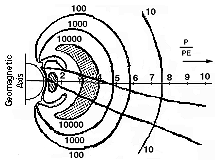|
Now and then a violent outburst, known as a magnetic storm, drives tail plasma earthward, into the near-Earth magnetosphere. Electric fields (voltage differences) are essential to this process, to help tail particles break into trapped orbits and to drive them to higher energies. When the outburst ends and the electric field dies away, the particles find themselves locked in trapped orbits of the ring current and the outer radiation belt. Lesser outbursts, known as magnetospheric substorms, occur quite frequently.
Whereas the inner belt is marked by great stability, the ring current and outer belt constantly change. Sooner or later the particles are lost, e.g. by collision with the rarefied gas of the outermost atmosphere, and on the other hand, new ones are frequently injected from the tail. The electric fields which inject the new particles can also draw oxygen ions upwards from the ionosphere, and the ring current contains such ions, typically a few percent of the total, more during magnetic storms.
|
 Two radiation belts
Two radiation belts Official GSFC Home Page
Official GSFC Home Page  NASA WWW Home Page
NASA WWW Home Page